A set of strong, broad shoulders signal to the world that you lift (hey, a little vanity is okay). Stronger shoulders also mean you can bench press and overhead press more weight while potentially staving off injuries.
While your shoulders are smaller muscles compared to your chest and back, don’t be tempted to throw shoulder training on the back burner. Directly training your shoulders is crucial for balanced upper body strength development. Below, we’ve curated a list of the best shoulder exercises you can do plus some of the best shoulder routines you can perform during your workouts.
Recent Updates: BarBend Senior Writer Jake Dickson revised this article to provide more accessible exercises and include movements that align more closely with BarBend’s evolving standards for training content. Read more about that process here.
13 Best Shoulder Exercises
- Barbell Overhead Press
- Dumbbell Shoulder Press
- Arnold Press
- Push Press
- Z Press
- Landmine Press
- Lateral Raise
- Face Pull
- Reverse Flye
- Y Raise
- Cable Lateral Raise
- Dumbbell Front Raise
- Shrug
What Muscles Make Up the Shoulders
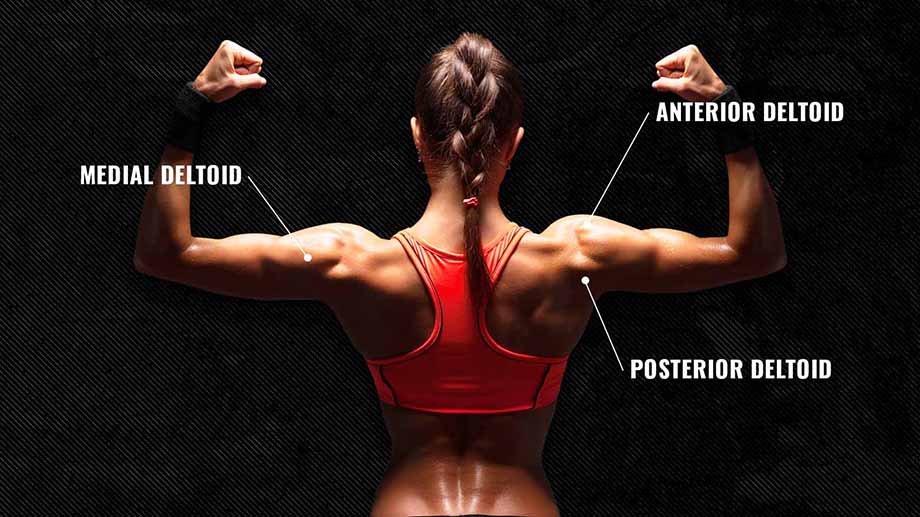
- Front Deltoid: This muscle is involved in all shoulder flexion movements like front raises and all vertical and horizontal pressing exercises (think: overhead presses, bench presses, and push-ups).
- Lateral Deltoid: Your lateral delts help with exercises like lateral raises and overhead presses that take your shoulder away from your body’s midline. You can also target your lateral delts by using a wider grip during these movements.
- Posterior Deltoid:. All movements that involve shoulder extension and external rotation train the posterior deltoid. Examples of these moves include bent-over reverse flyes, bent-over row variations, lat pulldowns, and chin-up and pull-up variations. The overhead lockout position trains the posterior deltoids, too.
There are also a small host of muscles directly atop, behind, and beside the scapulae themselves. Our expert Furr explains:
- Supraspinatus: Located above the spine of the scapula.
- Infraspinatus: Located below the spine of the scapula.
- Teres minor: Located at the lateral border of the scapula.
- Subscapularis: Located on the anterior surface of the scapula.
1. Barbell Overhead Press

| Equipment Needed | Barbell, squat rack, weight plates, wrist wraps (optional) |
| Muscles Worked | Anterior deltoid, triceps, upper back, core |
| Sets & Reps | 3-4 x 4-6 |
The barbell overhead press is one of the best delt exercises you can do. Why? It’s one of your fundamental movement patterns: “Even if you aren’t a weight lifter, you probably spend time outside the gym holding things above your head,” says Dickson.
If you’re wondering how to get bigger shoulders or want to strengthen your shoulder muscles, the overhead press should be among your first stops.
[Related: Best Upper Body Exercises]
How To Do It
- Grip a bar with an overhand grip, set up in a power rack or squat stand. Place your hands just outside your shoulders.
- Stack your elbows and forearms vertically.
- Place the bar deep in your palm because this is where you’ll generate the most force from.
- Press overhead until lockout then slowly lower down to the starting position.
Modifications
- Make It Easier: Set the bar in the rack on the safety arms to do pin presses.
- Make It Harder: Test your balance by doing the military press, standing with your feet touching.
2. Dumbbell Shoulder Press
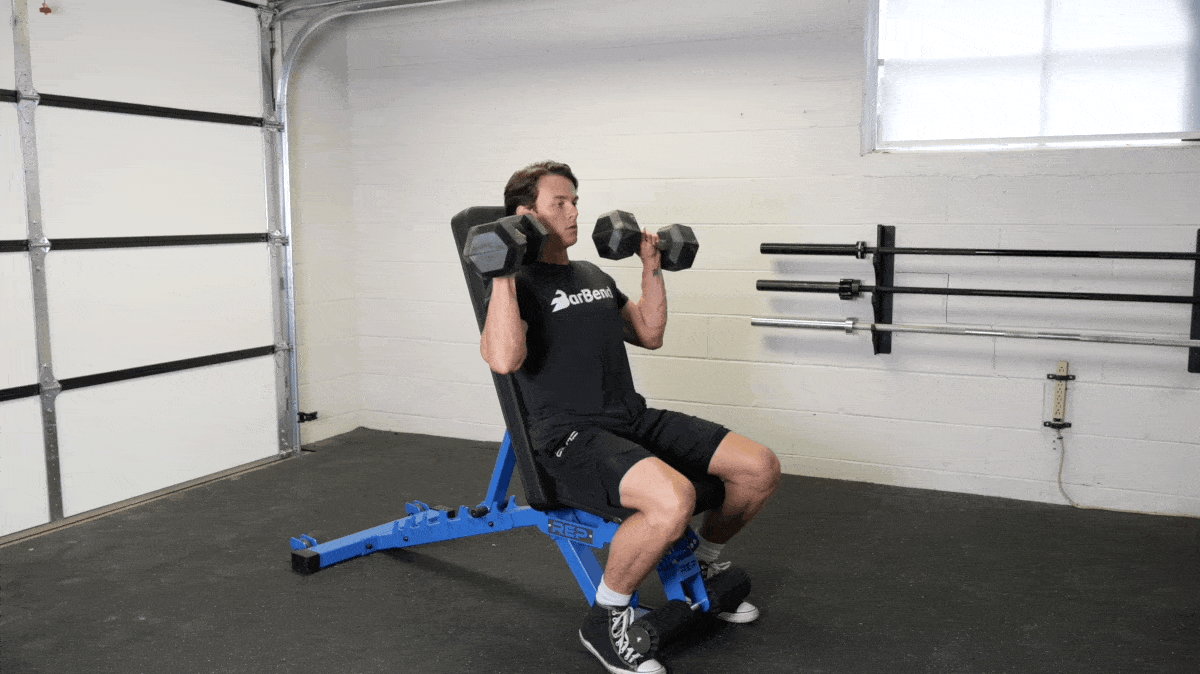
| Equipment Needed | Dumbbells, adjustable weight bench or seat, wrist wraps (optional) |
| Muscles Worked | Anterior deltoid, triceps |
| Sets & Reps | 3 x 8-12 |
Performing the dumbbell shoulder press seated — which isn’t required but we recommend it — allows you to drive more action to your shoulder by restricting your leg drive and the amount of momentum you can generate. This move trains all three heads of the deltoids, allows for freedom of movement, and, because you’re lifting the dumbbells separately, you’ll combat muscle and strength imbalances between sides.
How To Do It
- Sit upright on an incline bench.
- Kick the dumbbells up so you’re holding them just above your shoulders with your forearms vertical.
- Press both dumbbells overhead until your elbows lock out above your head.
Modifications
- Make It Easier: Choose a seat that has a backrest to help stabilize your spine.
- Make It Harder: Press each arm individually, suspending the non-working arm in space isometrically.
3. Arnold Press

[Read More: How To Do a Dumbbell Bench Press, With Expert Tips & Video Guide]
| Equipment Needed | Dumbbells, adjustable weight bench, wrist wraps (optional) |
| Muscles Worked | Anterior deltoid, medial deltoid, triceps, serratus anterior |
| Sets & Reps | 3 x 8-12 |
The Arnold press, named after bodybuilding icon Arnold Schwarzenegger, trains all three deltoid heads. Due to the larger range of motion and its rotational nature, it increases time under tension, leading to a greater hypertrophy potential.
When performed for higher reps, it is an absolute deltoid and upper back burner. The Arnold press requires mobility, stability, and strength to perform well. With this movement, you’ll cultivate discipline and immense overhead stability in multiple planes of motion.
How To Do It
- Sit upright on a weight bench, either supported or unsupported. Hoist dumbbells up to a traditional starting position.
- Rotate your hands until your palms are facing toward you, like at the top of a biceps curl.
- In one motion, press the dumbbells and rotate your palms to face forward as you lock your elbows out over your head.
Modifications
- Make It Easier: Try doing one arm at a time, holding the other arm out to the side for balance as you learn the movement pattern.
- Make It Harder: Try one-and-a-half-reps with the bottom half of the range of motion.
4. Push Press

| Equipment Needed | Barbell, bumper plates, squat rack, lifting belt (optional), wrist wraps (optional) |
| Muscles Worked | Deltoids, triceps, core, quads |
| Sets & Reps | 2-4 x 3-5 |
It looks like an overhead press at the start, but the push press uses leg drive to heft heavy weights overhead. You’ll dip slightly through your knees, then explode upward. The momentum from your lower body will help you move a lot more weight than you can with the strict overhead press.
How To Do It
- Set up the same as you would for the barbell overhead press.
- Assume an upright torso and dip downward four to six inches with your knees over your toes.
- Push your torso and chest upwards through the barbell, and using your legs, forcefully drive yourself and the barbell up.
- Continue to push through the barbell until lockout. Slowly return to the starting position and repeat.
Modifications
- Make It Easier: You can do behind-the-neck push presses if the front rack position is uncomfortable.
- Make It Harder: Try pausing at the bottom of the dip before pushing the bar off your shoulders with your legs.
5. Z Press

| Equipment Needed | Barbell or dumbbells, weight plates (optional) |
| Muscles Worked | Anterior deltoid, triceps, upper back, core, hip flexors |
| Sets & Reps | 2-3 x 10-12 |
The Z press is simply a shoulder press variation that you perform while sitting down with your legs extended in front of you. We like this one because it prevents any accommodation from your spine or hips; if you don’t have the shoulder flexibility and core strength to extend your arms above your head, the Z press will get you there.
How To Do It
- Sit with your legs straight underneath a barbell set into a squat rack at a low height. Or, sit in the same position on the floor, holding a dumbbell in each hand.
- Reach forward, grab the bar, unrack it, and sit tall with the bar (or dumbbells you’re already holding) in the front rack position.
- Brace your core, tilt your head back slightly, and press the bar (or dumbbells) overhead while keeping your legs on the ground and fully extended.
Modifications
- Make It Easier: Sitting cross-legged is generally a bit easier on your lower body while you learn how to do this exercise.
- Make It Harder: Gently lift one leg up off the floor and hold it midair to make the movement more challenging for your hips and core.
6. Landmine Press

| Equipment Needed | Landmine attachment (optional), barbell, weight plates |
| Muscles Worked | Anterior deltoid, triceps, core |
| Sets & Reps | 2-3 x 12-15 |
We’re fans of landmine, well, anything. This piece of equipment puts a unique spin on standard barbell exercises by changing the resistance profile.
“The landmine press is a versatile exercise that offers several benefits for building strength, improving stability, and enhancing overall athleticism,” Furr explains. “It can also be utilized for those that might not have the range of motion for an overhead press and can generally not cause as much pressure or stress on the shoulders.”
How To Do It
- Wedge a barbell into the corner of a wall or a landmine attachment if you have one.
- Face the bar and clasp the end of the shaft in one hand with your upper arm tucked against your torso and your elbow bent.
- Push the end of the bar up and away from your body.
Modifications
- Make It Easier: Take a wide stance and hold your non-working arm out to the side for balance.
- Make It Harder: As you press, “throw” the weight out and over to your other side and catch it with your free arm, then move directly into a repetition on that side.
7. Lateral Raise
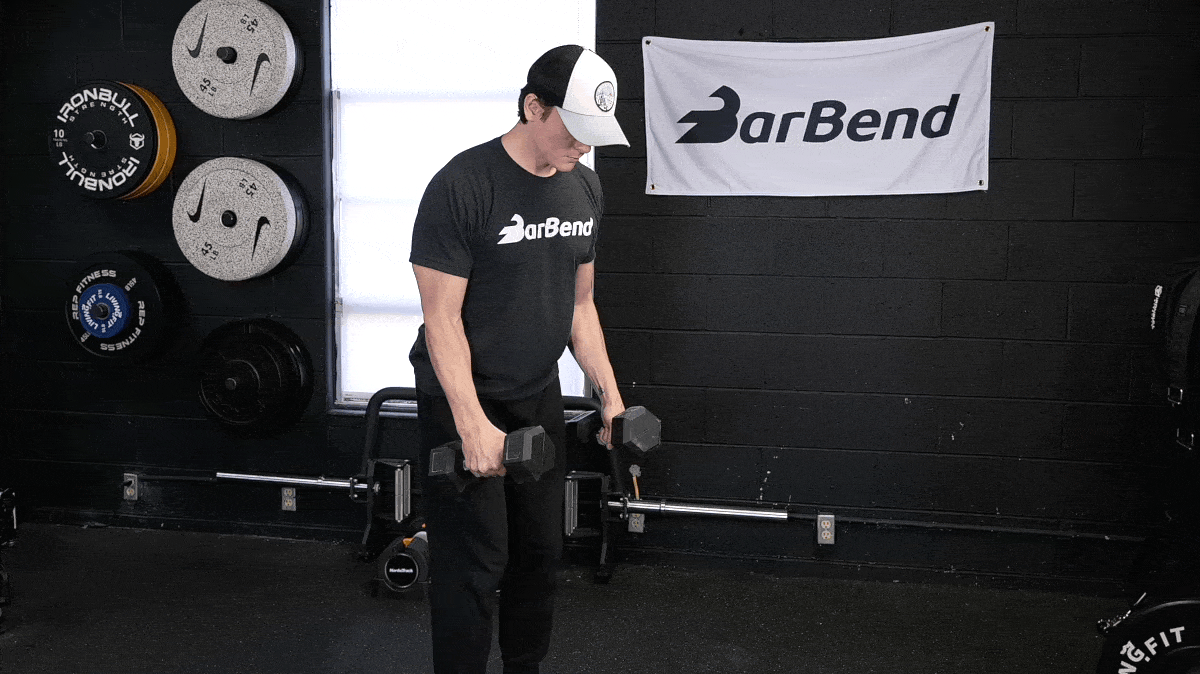
| Equipment Needed | Dumbbells |
| Muscles Worked | Medial deltoid |
| Sets & Reps | 2-4 x 15-25 |
The medial, as in middle, head of your deltoid has a specific function: It pulls your arm up and out to the side. Training this movement helps give your shoulders that round, three-dimensional look. However, it’s very hard to hit the medial deltoid through most compound exercises. To target it effectively, lateral raises are a must-do. We like dumbbells for this one for their accessibility.
How To Do It
- Stand upright with your feet under your hips and hold a pair of light dumbbells in either hand by your sides.
- Brace your core, and with your elbows mostly straight but not fully locked, lift your arms out to your sides.
- Raise the weights until your arms form a straight line and are parallel to the ground, then slowly lower the weights back down.
Modifications
- Make It Easier: Perform this move sitting down or with one arm at a time.
- Make It Harder: Try pausing at the top of each repetition.
8. Face Pull

| Equipment Needed | Adjustable cable station, rope attachment, or resistance band (optional) |
| Muscles Worked | Rear deltoid, trapezius, rotator cuff |
| Sets & Reps | 1-3 x 15-25 |
Your shoulder muscles require a good bit of upkeep due to how mobile they are compared to many other joints. Many people typically experience shoulder discomfort or pain if they perform too many pressing movements and neglect the back side of their shoulders.
To ensure things stay healthy and balanced, we recommend hitting up the face pull — a cable shoulder exercise that works wonders as a warm-up before an upper-body workout, or as a standalone move to finish off your training session.
How To Do It
- Set a cable station up around eye level with a rope attachment.
- Grab the ends of the rope and take a step back to pull the cable taut. Allow the rope to pull your arms out straight in front of your body.
- Bend your elbows and pull the rope toward your face, driving your elbows out and behind your body.
- Rotate your upper arm to externally rotate your shoulder as though you were performing a front-double-biceps bodybuilding pose.
Modifications
- Make It Easier: Set the cable to around waist height and take a kneeling position for this exercise.
- Make It Harder: Try pausing at the end of each repetition with your shoulder externally rotated.
9. Reverse Flye

[Read More: The Best Lower Back Exercises To Strengthen & Prevent Pain]
| Equipment Needed | Dumbbells, adjustable weight bench (optional) |
| Muscles Worked | Rear deltoid, rhomboids |
| Sets & Reps | 1-3 x 15-25 |
“Despite being the smallest part of your shoulder muscle, your rear deltoid plays an integral role in stabilizing your shoulder joint as a whole,” says Dickson.
You can do rear delt flyes or reverse flyes (they’re the same thing) with different equipment, but we generally prefer dumbbells for their simplicity.
How To Do It
- Set an adjustable weight bench to a low or medium incline and lay down on it on your stomach with a light dumbbell in each hand.
- Hang your arms down low, spreading your shoulder blades.
- With your arms straight but elbows unlocked, sweep your hands up and out to the sides until they’re parallel to the ground.
Modifications
- Make It Easier: Raise the angle of the bench to make the movement a bit easier.
- Make It Harder: Do this move without a bench, performing a hip hinge and holding your body motionless.
10. Y-Raise
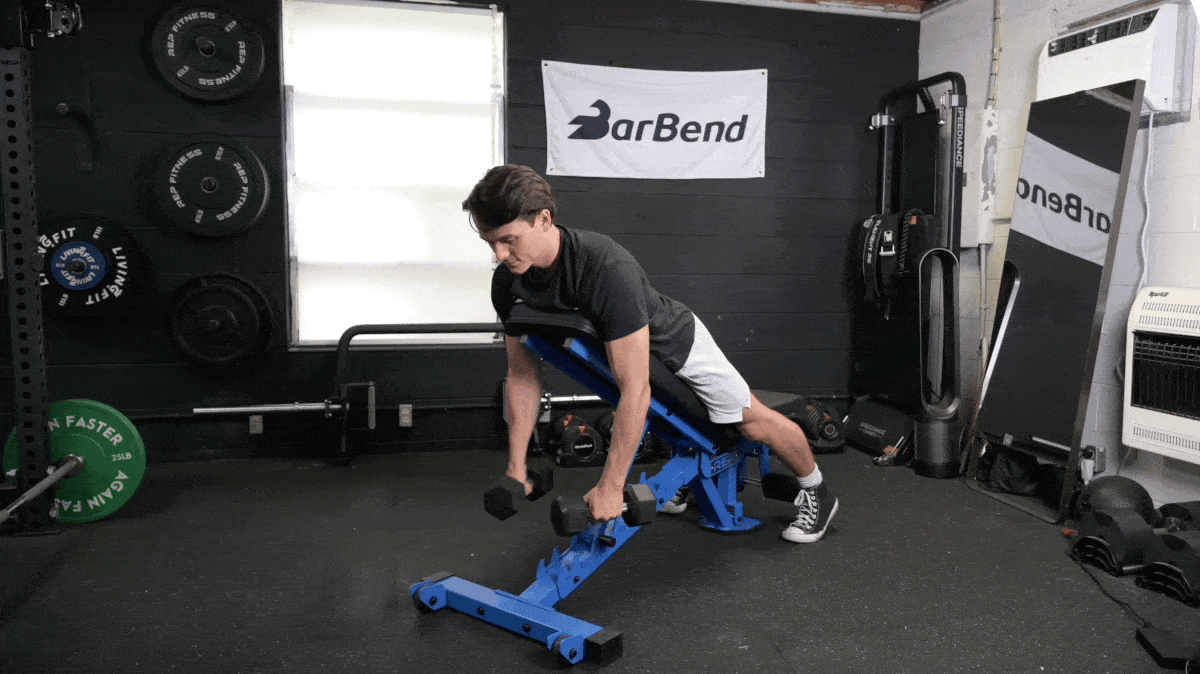
| Equipment Needed | Adjustable weight bench (optional), dumbbells |
| Muscles Worked | Medial deltoid, upper back, rotator cuff |
| Sets & Reps | 2-3 x 20 |
The Y-raise targets the upper back and traps. It’s also great for targeting your posterior deltoids from a different angle while strengthening all four muscles of the rotator cuff in the overhead position. By emphasizing your posterior deltoids and upper back, this move can help to promote good posture by strengthening those supporting muscles (which can become neglected in the gym).
How To Do It
- Set up the bench at a 45-degree incline. Lie face down with your knees slightly bent.
- Hold the weights with an overhand grip. Extend your arms to hang straight under your shoulders. Keep your shoulders down and chest up.
- Use your rear delts to raise the weights up and out. Keep your arms straight until they are fully extended. A soft bend in your elbows is okay.
- Slowly lower back to the starting position. Reset and repeat.
Modifications
- Make It Easier: Do this move while laying on an adjustable weight bench for support.
- Make It Harder: Do this movement while in a hinged position, bracing your core to remain stable and motionless.
11. Cable Lateral Raise

| Equipment Needed | Adjustable cable station, D-handle attachment or wrist cuff |
| Muscles Worked | Medial deltoid |
| Sets & Reps | 2-3 x 15-20 |
There’s more than one way to skin a cat, and there are plenty of lateral raise variations you can do for your shoulder muscles as well.
“If you’re trying to build boulder shoulders, I suggest you use a cable,” Dickson recommends. “The cable lateral raise provides constant tension to your shoulder and really help you establish a good mind-muscle connection with your delts.”
How To Do It
- Set the cable up around waist height and stand sideways to it, clasping the handle with your far-side arm.
- With your arm drawn across your body, step laterally to pull the cable taut off the stack.
- From here, keep a mostly straight arm and raise your hand diagonally upward until your arm is parallel to the floor.
Modifications
- Make It Easier: Use your non-working arm to brace against the cable station for support, or drop the cable fixture itself down to the floor, both of which will lessen the load.
- Make It Harder: Try pausing at the top of each repetition.
12. Dumbbell Front Raise

[Read More: The Best Dumbbell Exercises for Muscle Gain, Plus 3 Workouts]
| Equipment Needed | Dumbbells |
| Muscles Worked | Anterior deltoid |
| Sets & Reps | 1-2 x 12-15 |
The front part of your shoulder, called your anterior deltoid, gets plenty of work from chest exercises like bench press variations or just about any overhead pressing move you perform. That said, you may still want to include a bit of isolation work for this area as well. We recommend a standard front raise here, since it takes accessory muscles like your triceps or chest completely out of the equation.
How To Do It
- Stand upright with your feet under your hips while holding a dumbbell in each hand.
- Brace your core and, with straight arms, raise the weights out in front of your body until your upper arms are parallel to the ground.
Modifications
- Make It Easier: Do this move while leaning against a mostly-upright weight bench for support.
- Make It Harder: Try to hold the weights motionless at the top of each repetition.
13. Shrug
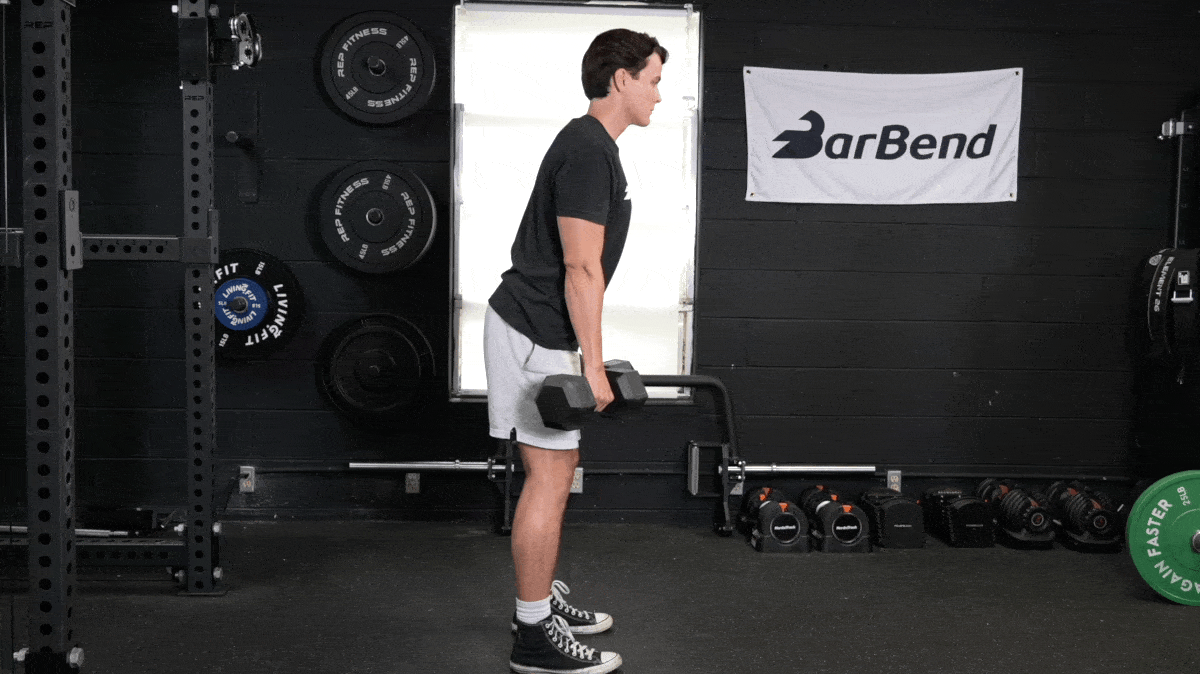
| Equipment Needed | Dumbbells, lifting straps (optional) |
| Muscles Worked | Trapezius |
| Sets & Reps | 2-3 x 12-15 |
Okay, okay, your traps aren’t technically a part of your shoulder. However, they do act directly on the shoulder joint and contribute to the biomechanical motion of scapular elevation. You’d be remiss to train your delts and neglect your traps, so we’d suggest doing some shrugs here and there. We like working with dumbbells for this one, but you can use a barbell or even a cable attachment if you like.
How To Do It:
- Stand upright while holding a pair of heavy dumbbells in-hand.
- Brace your core and fix your gaze ahead, then lean forward very slightly.
- While keeping your elbows locked, raise your shoulders up toward your ears.
Modifications
- Make It Easier: Use a pair of lifting straps to keep your grip snug while you shrug.
- Make It Harder: Try doing snatch-grip shrugs with a barbell or Smith machine, holding the bar with a wide grip.
5 Shoulder Workouts
The best shoulder exercises in the world won’t do you a lick of good if you can’t compile them into functional, practical, effective shoulder workout routines. Luckily, we’re taking that out of your hands. Here are four of our preferred shoulder workout routines, curated by our training staff to help you reach your goals (but first, you’ve got to warm up!):
Shoulder Warm-Up
Don’t be the person who walks into the gym, slaps a plate or two onto the barbell, and starts bench pressing. Shoulder joints tend to be sensitive and prone to injury. You need to take the time to warm it up with a few movements that rotate, raise, and abduct the shoulder.
A few low-intensity exercises which target the shoulder area will get you ready for action.
| Exercise | Sets | Reps |
|---|---|---|
| Shoulder CAR | 2 | 10 per side |
| Wrist Roll | 2 | 30 seconds per direction |
| Dead Bug | 2 | 15 per side |
| Resistance Band Face Pull | 2 | 25-20 |
| TRX I-Y-T | 2 | 8-10 |
| Exercise-Specific Ramp-Up Set | 2-5 | 5-10 |
[Read More: The Best Mobility Exercises From a Physical Therapist (+ Tips)]
Perform slowly. Start with a conservative range of motion, and slowly increase your range with each rep.
Especially with presses, make sure you’re performing an appropriate number of ramp-up sets. Start with an empty barbell — no matter how heavy you will ultimately go — and work up gradually from there.
Even with smaller, isolation exercises, go through the motions with extremely light weight (or even just your body weight) to prepare your shoulders for the motion.
Shoulder Workout for Beginners
If you’re a beginner, your shoulder workouts don’t need to be complicated. One pressing movement and an exercise to target the side and back of your shoulder will do just fine.

[Read More: The Best Forearm Exercises for Strength, Plus Workouts]
- Barbell Shoulder Press: 3 x 6
- Dumbbell Lateral Raise: 3 x 12
- Reverse Flye: 3 x 15
Shoulder Workout for Strength
Strengthening your shoulders is a two-fold endeavor: You need to hit your presses hard and heavy with progressive overload while also ensuring your shoulder joints remain healthy and functional.

- Band Pull-Apart: 1 x 20
- Push Press: 3 x 3
- Dumbbell Shoulder Press: 3 x 6-8
- Lateral Raise: 3 x 12-15
- Face Pull: 2 x 20
Shoulder Workout for Muscle
Shoulder workouts for bodybuilding are where things get interesting. Most bodybuilders get plenty of front delt work on chest day, so you may not need a big pressing movement to build up your delts. Instead, let’s focus on the middle and rear deltoids, which most people tend to neglect.

- Arnold Press: 3 x 8-10
- Dumbbell Lateral Raise: 2 x 10-12
- Cable Lateral Raise: 2 x 12-15
- Reverse Flye: 2 x 15-20
- Face Pull: 2 x 20
Shoulder Workout at Home
Shoulders can be difficult — but not impossible — to train at home with limited equipment. If you don’t have room overhead to do pressing movements, don’t fret. We have alternatives. All you need for this at-home shoulder workout workout are some dumbbells.

[Read More: The Best Adjustable Dumbbells for Your Home Gym]
- Z Press: 3 x 8
- Dumbbell Lateral Raise: 3 x 15
- Shrug: 2 x 20
Shoulder Workout for Injury Recovery
If you have a shoulder injury, the best thing to do is seek out a qualified physiotherapist for assistance. Beyond that, you may be able to remedy or mitigate shoulder pain by performing movements that target and strengthen all areas of your shoulder, especially the rear deltoid and muscles that enwrap the rotator cuff. (1)

- Y-Raise: 2 x 15-20
- Face Pull: 2 x 15-20
- Scapular Push-Up: 2 sets to failure
- Scapular Dip: 2 sets to failure
Shoulder Training Tips
Building out your shoulders isn’t as simple as overhead pressing — though yes, pressing is a big part of the equation, especially since there aren’t too many viable bodyweight shoulder exercises out there. To maximize your shoulder growth, turn to these tricks and tips.
[Related: The Best Arm Exercises You Can Do]
Train Your Rear Delts
Your rear delts often get the short end of the stick when it comes to shoulder workouts. “The rear deltoid is hard to hit, but is extremely valuable in general shoulder health as well as making your delts ‘pop’ visually,” Dickson notes.
[Read More: The Ultimate Workout Split, Created by Our Experts]
And while the rear delts do have assistance roles, they’re dominated by other muscles such that they aren’t the primary movers. To compensate — and build well-rounded shoulders — emphasize rear delt isolation work in your shoulder programming.
Train Your Lateral Delts
When it comes to the best exercises for big shoulders, it is absolutely essential to train your lateral delts. For these isolation exercises, you’ll typically go a lot lighter than you will with rear delt exercises. You want to tax your lateral delts enough to stimulate growth, but not so much that you’re setting yourself up for overuse injuries.
If you try to lift too heavy with lateral delt moves, your body will tell you. You’ll find yourself needing to kip and use extra momentum from the first rep on — and you won’t be able to control the eccentric (which is crucial for promoting growth). Make sure you can control the eccentric and that you don’t need momentum to start each rep.
[Read More: Our Powerbuilding Workout Routine, With Tips from a CPT]
Sure, you can use a little body English to eke out some extra gains at the end of your sets. But you’ll benefit most from using a weight that allows you to start with clean form.
Train Your Front Delts
Your front delts get a lot of tension from pressing. Whether you’re overhead pressing, jerking, or even bench pressing, your front delts will feel it. But that’s no reason to not train them on their own, too.
Train your front delts with isolation movements using lighter weights. Follow the same protocols as you do with lateral delt single-joint exercises — control the eccentric and avoid momentum on the way up. Yes, let body English kick in toward the end of your sets. But for the most part, emphasize the muscle itself to maximize the effects of isolation.
Benefits of Training Your Shoulders
Beginners and advanced athletes alike benefit from training their shoulders. Even if your bread-and-butter lifts have nothing to do with overhead pressing, you’ll likely benefit a great deal from exercises for the shoulders. These moves will emphasize a combination of mobility and stability that can improve your movements both in and out of the gym.
Overhead Stability
First things first — shoulder training improves posture. Particularly if you spend a lot of time sitting down or hunched over a keyboard or your smartphone, you’ll feel the difference when you train your shoulders. This is especially true of training your rear delts. Strong shoulders will help you stay upright during even the most intense sessions of data entry.

[Read More: The Best Back Exercises]
In the gym itself, developing overhead stability is critical for compound exercises as diverse as the snatch, the log press, and overhead lunges. Even bench pressing requires a tremendous amount of stability in your upper body.
Strengthening the muscles around your shoulder joint won’t just make you stronger at lifting. It can also help bolster you against potential shoulder injury, making your shoulders more resilient. (2)
Shoulder Mobility
Sometimes shoulders aren’t only about shoulders. Do you want to try a low bar back squat to help you squat heavier weights? Guess what you need — shoulder mobility. To maintain your joint health and help you hit new PRs, you’ll need a combination of shoulder stability and mobility.
Training your shoulders requires you to pay special attention to where these joints need improvement. If you can’t take an exercise through its full range of motion, you’ll know to work on this both during your dynamic warm-ups and in your workouts themselves.
Aesthetics
Physique-oriented athletes, rejoice — training your shoulders will help give your body a crucial part of that filled-out V-taper. If you neglect training these muscles specifically and only focus on pressing, you’ll likely find that your shoulders may be decent in the front, but lack fullness around the sides and back.
[Read More: The Best Biceps Exercises for Your Next Workout]
This fullness (think: boulder shoulders) is a critical part of what a lot of people are chasing when they want to build upper body muscle mass. Training your shoulders directly instead of relying on presses alone to get you there will skyrocket your physique gains.
Frequently Asked Questions
How many shoulder exercises should you do per workout?
Generally speaking, each of the shoulder’s three heads needs one, maybe two, exercises. In practice, this will look like a dumbbell shoulder exercise like the overhead press (you can use a barbell too), followed by a lateral raise variation, and then a rear delt exercise to finish things off.
What shoulder exercises hit all deltoid muscles?
There’s no single movement that adequately stimulates your entire shoulder; the three heads of the deltoid perform separate, and in some cases contradictory, anatomical functions. However, a move like the Arnold press comes pretty close because it introduces some rotation around the shoulder joint instead of simply requiring you to press the weight up and down.
How do you build bigger shoulders?
You can grow your shoulders the same way you’d gain muscle anywhere else. Pick exercises that are safe, fun, and sustainable, and progress in weight or reps over time. Make sure you’re eating enough to gain muscle as well!
Should I train shoulders every day?
Heck no. Your shoulders are a muscle like any other, and they require rest after a vigorous workout. You also use your shoulder muscles during many chest and back exercises, so you don’t want to overdo it with the training frequency. Stick to two or three weekly shoulder workouts at most.
References
- Serra-Añó, P., Pellicer-Chenoll, M., García-Massó, X. et al. Effects of resistance training on strength, pain and shoulder functionality in paraplegics. Spinal Cord 50, 827–831 (2012).
- Shitara H, Tajika T, Kuboi T, Ichinose T, Sasaki T, Hamano N, Kamiyama M, Yamamoto A, Kobayashi T, Takagishi K, Chikuda H. Shoulder stretching versus shoulder muscle strength training for the prevention of baseball-related arm injuries: a randomized, active-controlled, open-label, non-inferiority study. Sci Rep. 2022 Dec 21;12(1):22118. doi: 10.1038/s41598-022-26682-1. PMID: 36543874; PMCID: PMC9772170.
Featured image: Jacob Lund / Shutterstock